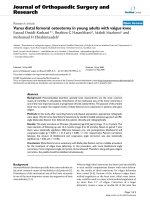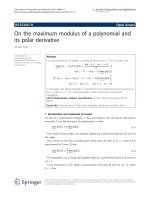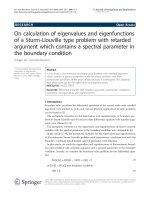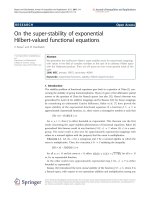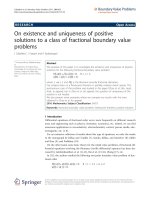Báo cáo hóa học: " On general filtering problem of stationary processes with fixed transformation" pot
Bạn đang xem bản rút gọn của tài liệu. Xem và tải ngay bản đầy đủ của tài liệu tại đây (288.41 KB, 10 trang )
RESEARC H Open Access
On general filtering problem of stationary
processes with fixed transformation
Long suo Li
Correspondence:
Department of Mathematics,
Harbin Institute of Technology,
Harbin 150001, P.R.China
Abstract
A fixed transformation are given for one-dimensional stationary processes in this
paper. Based on this, we propose a general filtering problem of stationary proce sses
with fixed transformation. Finally, on a stationary processes with no any additional
conditions, we get the spectral characteristics of
P
H
η
(
t
)
ξ
in the space L
2
(F
X
(dl)), and
then we calculate the value of the best predict quantity Q of the general filtering
problem.
Keywords: stationary proces ses, fixed transformation, fillering
1. Introduction
The Prediction theory is an important part of stationary processes, also linear filter
problems is an important part of Prediction theory. The linear filtering problem of
multidimensional stationary sequence and processes for a linear system are firsted stu-
died by Rosanov in [1], and then a series of general filter problem of stationary process
for a linear system are studied in [2-9]. Theoretica lly, this problem is a extend of the
classic prediction problem. But it has high practical value, it also widely applied in
communication, exploration, space technology and automatic control, etc.
2. Propose the problem
Let X(t),tÎ R be (simple) wide stationary process. Let
H
X
= L{X(t), t ∈ R}
H
X
(
t
)
= L{X
(
s
)
, s ≤ t, s ∈ R
}
Suppose the complex-value function b (t) statisfing the following conditions
1)
b
(
t
)
∈ L
[0, +∞
)
∩ L
2
[0, +∞
)
(2 À 1)
2)
b
(
t
)
for t <
0
(2 À 2)
Let
B(λ)=
∞
0
b(t)e
−iλt
dt
(2 À 3)
Li Journal of Inequalities and Applications 2011, 2011:68
/>© 2011 L i; licensee Springer. This is an Open Access article distributed under the terms of the Creative Commons Attribution License
( which permits unrestrict ed use, distribution, and reproduction in any medium, provided
the original work is properly cited.
then B(l) is boundary values analytic function B(z) in the low half plane
We can obtain
B
(
λ
)
=0, a.e. Le
b
Let
E = {λ : B
(
λ
)
=0}, E =
(
−∞, ∞
)
−
E
(2 À 4)
then
L
(
E
)
=
0
Let
η(t)=
∞
0
b(s) · X(t − s ) ds =
∞
0
b(s)U
−s
X(t)d
s
(2 À 5)
where U is the shift oprator of X(t) in the space H
X
.
Then, for each ξ Î H
X
1) Find out the value of Q,
Q =inf
ξ∈H
X
(
t
)
∞
0
b (s)U
−s
ξ ds −
ξ
2
(2 À 6)
2) Then, we will prove that
Q = ||P
H
η
(t)
ξ − ξ ||
2
and solve the spectral characteristics of
P
H
η
(t
)
in the space L
2
(F
X
(dl)).
3. Main result
Let the random spectral measure of X(t)isF
X
(dl), and the spectral measure is F
X
(dl), the broad spectral measure which also named the spectral measure of absolutely
continuous part of F is f
X
(l).
The Lebesgue decomposition of F
X
(dl)is
F
X
(
dλ
)
= f
X
(
λ
)
dλ + δ
(
dλ
)
(3 À 1)
where the Lebesgue measure of δ(dl) is singular, namely δ(l)=c
Δ
(l)F
X
(dl)
⊂
(
−∞, ∞
)
, L
(
)
=0, =
(
−∞, ∞
)
−
Let
A
t
=
h : h =
∞
0
b(s)U
−s
yds, y ∈ H
X
(t )
(3 À 2)
Obviously, At is linear set.
Lemma 1. Let X(t),tÎ R is stationary processes, F (dl) and Z(dl) are spectral mea-
sure and random spectral measure respectively. ∀f(l), (l) Î L
2
(F), and |(l)| ≤ M, M
>0, where M is real number, we have
Li Journal of Inequalities and Applications 2011, 2011:68
/>Page 2 of 10
∞
−∞
f (λ)ϕ(λ)Z(dλ)
≤ M
∞
∞
f (λ)Z(dλ)
Proof. According to the nature of the random integral, we have
∞
−∞
f (λ)ϕ(λ)Z(dλ)
=
∞
−∞
|f (λ)ϕ(λ)|
2
F( dλ)
1
2
=
∞
−∞
|f (λ)|
2
·|ϕ(λ)|
2
F( dλ)
1
2
≤ M
∞
−∞
|f (λ)|
2
· F(dλ)
1
2
= M
∞
−∞
f (λ)Z(dλ)
Lemma 2.
L
{A
t
} = H
η
(t
)
(3 À 3)
where
L
(
A
t
)
is the linear closed manifold of A
t
.
Proof. ∀h (τ
0
), τ
0
≤ t, Let y = X(τ
0
), we have y Î H
X
(t), and
η(τ
0
)=
∞
0
b(s)U
−s
yds =
∞
0
b(s)U
−s
X(τ
0
)d
s
namely, h (τ
0
) Î A
t
, then
H
η
(t ) ⊂
L
(A
t
)
On the other hand, ∀h Î A
t
, we have
h =
∞
0
b(s)U
−s
yd
s
where y Î H
X
(t).
Let
z
l
=
m
l
k
=1
a
l
k
X(t
l
k
), t
l
k
≤ t, k =1,2,··· , m
l
,
a
l
k
, is complex number. Let
|
|y − z
l
|| → 0
(
l →∞
)
while
∞
0
b(s)U
−s
z
l
ds =
m
l
k
=1
a
l
k
∞
0
b(s)U
−s
X(t
l
k
)ds ∈ H
η
(t ), l =1,2, ··
·
Let, the spectral characteristics of y and z
t
are ψ
y
(l)and
ψ
z
l
(λ
)
in the s pace L
2
(F
X
(dl)) respectively. According to the equation (2-3)
Li Journal of Inequalities and Applications 2011, 2011:68
/>Page 3 of 10
|
B(λ)| =
∞
0
b(s)e
−iλs
ds
≤
∞
0
|b(s)|ds
∧
=
M
where M>0 is constant. According to the lemma 1, we get
h −
∞
0
b(s)U
−s
z
l
ds
=
∞
0
b(s)U
−s
(y − z
l
)ds
=
∞
0
b(s)
∞
−∞
e
−isλ
(ψ
y
(λ) − ψ
z
l
(λ))
X
(dλ)ds
=
∞
−∞
(ψ
y
(λ) − ψ
z
l
(λ))
∞
0
b(s)e
−isλ
ds
X
(dλ)
=
∞
−∞
(ψ
y
(λ) − ψ
z
l
(λ))B(λ)
X
(dλ)
≤ M
∞
−∞
(ψ
y
(λ) − ψ
z
l
(λ))
X
(dλ)
= M
∞
−∞
|ψ
y
(λ) − ψ
z
l
(λ)|
2
F( dλ)
1
2
= M||y − z
l
|| → 0
(
l →∞
)
so, h Î H
h
(t), namely
L{A
t
}⊂H
η
(t
)
Then, it shows the equation (3-3) is correct.
According to the lemma 2, we have
Q =inf
ξ∈H
X
(t)
∞
0
b(s)U
−s
ξds − ξ
2
=inf
h∈A
t
||h − ξ||
2
=inf
h∈L{A
t
}
||h − ξ||
2
=inf
h∈H
η
(t)
||h − ξ||
2
= ||P
H
η
(t)
ξ − ξ ||
2
(3 À 4)
According to the equation (2-5) and (2-1), we get
η(t)=
∞
0
b(s)X(t − s)ds =
∞
0
b(s)
∞
−∞
e
i(t−s)λ
X
(dλ)ds
=
∞
−∞
e
itλ
∞
0
b(s)e
−isλ
ds
X
(dλ)=
∞
−∞
e
itλ
B(λ)
X
(dλ
)
on the other hand
η(t)=
∞
−
∞
e
itλ
η
(dλ
)
According to the stochastic process spectral theorem and the Relevant function spec-
tral theorem, we have
Li Journal of Inequalities and Applications 2011, 2011:68
/>Page 4 of 10
η
(dλ)=B(λ)
X
(dλ
)
(3 À 5)
F
η
(dλ)= |B(λ)|
2
F
X
(dλ
)
(3 À 6)
f
η
(dλ)= |B(λ)|
2
f
X
(λ
)
(3 À 7)
where F
h
(dl),F
h
(dl),f
h
(l) representative the random spectral measure, spectral
measure and broad spectral measure of h(t).
Lemma 3. Let ξ Î H
X
,
ξ
=
ξ
+
ξ
, where
ξ ∈ H
η
,
ξ⊥H
η
, then
Q = ||
ξ||
2
+ ||P
H
η
(t)
ξ −
ξ||
2
(3 À 8)
If, the wold decomposition of h (t)is
η
(
t
)
= η
r
(
t
)
+ η
s
(
t
)
and
ξ
=
ξ
r
+
ξ
s
where h
r
is regular process, h
s
(t) is singular process, and
ξ
r
⊥S
η
·
ξ
s
∈ S
η
,
S
η
=
t
H
η
(t )
, then
Q = ||
ξ ||
2
+ ||P
H
η
r(t)
ξ
r
−
ξ
r
||
2
(3 À 9)
Proof. According to
ξ
=
ξ
+
ξ
,
ξ ∈ H
η
,
ξ⊥H
η
,So
P
H
η
(t)
ξ = P
H
η
(t)
ξ + P
H
η
(t)
ξ = P
H
η
(t)
ξ
According to the equation (3-4),
Q = ||P
H
η
(t)
ξ − ξ ||
2
= ||P
H
η
(t)
ξ − (
ξ +
ξ)||
2
= ||(P
H
η
(t)
ξ −
ξ) −
ξ||
2
also, according to
ξ⊥(P
H
η
(t)
ξ −
ξ
)
,So
Q = ||
ξ||
2
+ ||P
H
η
(t)
ξ −
ξ||
2
namely, the equation (3-8) is correct.
When h (t) have the wold decomposition, notice
ξ
S
= P
H
η
ξ, H
η
(t )=H
η
r
(t ) ⊕ S
η
we get
P
H
η
(t)
ξ
s
= P
H
η
(t)
(P
S
η
ξ )=P
S
η
ξ =
ξ
s
(3 À 10)
P
H
η
(t)
ξ
r
= P
H
η
r
(t)
ξ
r
+ P
S
η
ξ
r
= P
H
η
r
(t)
ξ
r
(3 À 11)
So
||P
H
η
(t)
ξ −
ξ||
2
= ||(P
H
η
(t)
ξ
r
+ P
H
η
(t)
ξ
s
− (
ξ
r
+
ξ
s
)||
2
= ||P
H
η
r
(t)
ξ
r
−
ξ
r
||
2
Li Journal of Inequalities and Applications 2011, 2011:68
/>Page 5 of 10
Then, according to the equation (3-8), we get that the equation (3-9) is correct.
Lemma 4.Letξ Î H
X
,
ξ
=
ξ
+
ξ
,where
ξ ∈ H
η
,
ξ⊥H
η
, ψ(l) is spectral characteristics
of ξ in the space of L
2
(F
X
(dl)),
ψ
(
λ
)
is spectral characteristics of
ξ
in the space of L
2
(F
h
(dl)), then
1) when
λ
∈
E
,
ψ
(
λ
)
=
ψ
(
λ
)
B
(
λ
)
, a.e. F
X
(
dλ
)
(3 À 12)
2)
|
|
ξ||
2
=
E
|ψ(λ)|
2
F
X
(dλ
)
(3 À 13)
Proof. 1) According to the given conditions, we have
ξ =
∞
−∞
ψ(λ)
X
(dλ)
ξ =
∞
−∞
ψ(λ)
η
(dλ)=
∞
−∞
ψ(λ)B(λ)
X
(dλ
)
η(t)=
∞
−
∞
e
itλ
η
(dλ)=
∞
−
∞
e
itλ
B(λ)
X
(dλ)
So
(ξ, η(−t)) =
∞
−
∞
e
itλ
ψ(λ)B(λ)F
X
(dλ
)
on the other hand
(ξ, η(−t)) = (
ξ +
ξ, η(−t)) = (
ξ, η(−t)
)
=
∞
−
∞
e
itλ
ψ(λ)|B(λ)|
2
F
X
(dλ)
According to the Fourier transformation, we have
ψ
(
λ
)
B
(
λ
)
=
ψ
(
λ
)
|B
(
λ
)
|
2
,a.e.F
X
(
dλ
)
So, when
λ
∈
E
, we have
ψ
(
λ
)
=
ψ
(
λ
)
B
(
λ
)
,a.e.F
X
(
dλ
)
2) According to
ξ
=
ξ
+
ξ
, and
ξ
⊥
ξ
, Thus
||
ξ
||
2
= ||
ξ
+
ξ
||
2
= ||
ξ
||
2
+ ||
ξ
||
2
||
ξ||
2
= ||ξ||
2
−||
ξ ||
2
=
∞
−∞
|ψ(λ)|
2
F
X
(dλ) −
∞
−∞
|
ψ(λ)|
2
F
η
(dλ)
=
∞
−∞
|ψ(λ)|
2
F
X
(dλ) −
∞
−∞
|
ψ(λ)|·|B(λ)|
2
F
X
(dλ)
=
∞
−∞
χ
E
(λ)|ψ(λ)|
2
F
X
(dλ)+
∞
−∞
χ
E
(λ)|ψ(λ)|
2
F
X
(dλ) −
∞
−∞
χ
E
(λ)|
ψ(λ)|
2
·|B(λ)|
2
F
X
(dλ
)
=
∞
−
∞
χ
E
(λ)|ψ(λ)|
2
F
X
(dλ)=
E
|ψ(λ)|
2
F
X
(dλ)
Li Journal of Inequalities and Applications 2011, 2011:68
/>Page 6 of 10
namely, the equation (3-13) is correct.
Theorem.Letξ Î H
X
,
ξ
=
ξ
+
ξ
,where
ξ ∈ H
η
,
ξ⊥H
η
, ψ(l) repr esentative the spec-
tral characteristics of ξ in the space of L
2
( F
X
(dl)),
ψ
(
λ
)
representative the spectral
characteristics of
ξ
in the space of L
2
(F
h
(dl)). Then
1) When
log
f
X
(λ)
1+
λ
2
/∈ L
1
(−∞, ∞
)
Q =
E
|ψ(λ)|
2
F
X
(dλ
)
(3 À 14)
now the spectral characteristics of
P
H
η
(
t
)
ξ
in the space of L
2
(F
X
(dl)) is
ψ(λ)=
⎧
⎨
⎩
0, λ ∈ E,
a.e. F
X
(dλ
)
ψ(λ), λ ∈ E.
(3 À 15)
2) When
log
f
X
(λ)
1+λ
2
∈ L
1
(−∞, ∞
)
Q =
E
|ψ(λ)|
2
F
X
(dλ)+
∞
t
|ϕ(−s)|
2
d
s
(3 À 16)
now the spectral characteristics of
P
H
η
(
t
)
ξ
in the space of L
2
(F
X
(dl)) is
ψ(λ)=
⎧
⎪
⎨
⎪
⎩
0, λ ∈ E,
ψ(λ), λ ∈
E
,
B(λ)
∞
−t
e
−isλ
ϕ(s)ds
(
λ
)
, λ ∈ E
(3 À 17)
where b(t),B(l), h(t),Eand Δ is decided by the equation (2-1), (2-2), (2-3), (2-5), (2-
4) and (3-1) respectively. Where Γ(l) is the maximal factor boundary values of the
spectral density f
h
(l) , (l) is the Fourier transformation of
ψ
(
λ
)
(
λ
)
,where
ψ
(
λ
)
is
determined by equation (3-12) and
ψ
(
λ
)
= ψ
(
λ
)
/B
(
λ
)
, a.e. L.
Proof. 1) When
log
f
X
(λ)
1+λ
2
/∈ L
1
(−∞, ∞
)
. According to
f
η
(λ)= |B(λ)|
2
f
X
(λ
)
(3 À 18)
log |B
(
λ
)
|∈L
1
(
−∞, ∞
)
(3 À 19)
we know that
log f
η
(λ)
1+λ
2
/∈ L
1
(−∞, ∞
)
Thus, h(t) is singular process. So
H
η
= S
η
P
H
η
(t)
ξ = P
H
η
ξ = P
S
η
ξ =
ξ
According to (3-8)
Q = ||
ξ||
2
=
E
|ψ(λ)|
2
F
X
(dλ)
.
Li Journal of Inequalities and Applications 2011, 2011:68
/>Page 7 of 10
On the other hand
P
H
η
(t)
ξ = P
H
η
(
ξ +
ξ )=P
H
η
ξ = P
S
η
ξ =
ξ
The spectral characteristics of
P
H
η
(
t
)
ξ
in the space L
2
(F
X
(dl)) is
ψ
(
λ
)
=
ψ
(
λ
)
B
(
λ
)
, a.e. F
X
(
dλ
)
According to the equation (3-12), we get
ψ(λ)=
⎧
⎨
⎩
0, λ ∈ E,
a.e. F
X
(dλ
)
ψ(λ), λ ∈ E,
2) When
log f
X
(λ)
1+
λ
2
∈ L
1
(−∞, ∞
)
, according to (3-18) and (3-19), we
get
log f
η
(λ)
1+
λ
2
∈ L
1
(−∞, ∞
)
.
It shows that h(t) is non-singular process, so h(t) has regular singular decomposition,
and it consistent with Lebesgue-Gramer decompo sition. Let the decomposition equa-
tion is
η
(
t
)
= η
r
(
t
)
+ η
s
(
t
)
where h
r
(t) is regular process, h
s
(t) is singular process
η
r
(t )=
∞
−∞
e
itλ
η
r
(dλ)=
∞
−∞
e
itλ
χ
(λ)
η
(dλ
)
η
s
(t )=
∞
−
∞
e
itλ
η
s
(dλ)=
∞
−
∞
e
itλ
χ
(λ)
η
(dλ)
Let V (ds) is basic cross stochastic measure, namely
V
(
1
)=
∞
−
∞
e
iλt
2
− e
iλt
1
iλ
(dλ
)
where Δ
1
=(t
1
,t
2
], stochastic measure
(dλ)=
1
(λ)
η
r
(dλ
)
, Thus
η
r
(t )=
t
−
∞
C(t − s)V(ds
)
when
C(s)=
1
2
π
∞
−∞
e
isλ
(λ)d
λ
, and Γ(l) satisfate the follow conditions
f (λ)=
1
2
π
|(λ)|
2
also Γ(l) is the boundary values of the lower half plane maximum analytic functions
Γ(z), notice
ξ
r
=
∞
−∞
ψ(λ)χ
(λ)
η
(dλ)=
∞
−∞
ψ(λ)
η
r
(dλ
)
=
∞
−∞
ψ(λ)(λ)(dλ)
ξ
s
=
∞
−
∞
ψ(λ)χ
(λ)
η
(dλ)=
∞
−
∞
ψ(λ)
η
s
(dλ)
Li Journal of Inequalities and Applications 2011, 2011:68
/>Page 8 of 10
Let (s) is the Fourier transforation of
ψ
(
λ
)
(
λ
)
, namely
ϕ(s)=
1
2π
∞
−
∞
e
isλ
ψ(λ)(λ)d
λ
According to the Fourier transformation of random measure
ξ
r
=
∞
−∞
ψ(λ)(λ)(dλ)=
∞
−∞
∞
−∞
e
−iλs
ϕ(s)ds(dλ
)
=
∞
−
∞
∞
−
∞
e
iλs
ϕ(−s)ds(dλ)=
∞
−
∞
ϕ(−s)V(ds)
Thus
P
H
η
r
(t)
ˆ
ξ
r
=
t
−∞
ϕ(−s)V(ds)
|
|P
H
η
r
(t)
ˆ
ξ
r
−
ˆ
ξ
r
||
2
=
∞
t
ϕ(−s)V(ds)
2
=
∞
t
|ϕ(−s)|
2
d
s
According to the equation (3-9), we get
Q =
E
|ψ(λ)|
2
F
X
(dλ)+
∞
t
| ϕ(−s)|
2
d
s
According to the Lemma 3
P
H
η
(t)
ξ = P
H
η
(t)
ξ = P
H
η
(t)
ξ
r
+ P
H
η
(t)
ξ
s
= P
H
η
r
(t)
ξ
r
+
ξ
s
notice
P
H
η
r
(t)
ξ
r
=
t
−∞
ϕ(−s)V(ds)=
∞
−∞
t
−∞
e
iλs
ϕ(−s)ds
(dλ)
=
∞
−∞
∞
−t
e
−iλs
ϕ(s)ds
1
(λ)
η
r
(dλ)
=
∞
−∞
∞
−t
e
−iλs
ϕ(s)ds
1
(λ)
χ
(λ)B(λ)
X
(dλ)
ξ
s
=
∞
−
∞
ψ(λ)χ
(λ)
η
(dλ)=
∞
−
∞
ψ(λ)χ
(λ)B(λ)
X
(dλ
)
Thus
P
H
η
(t)
ξ =
∞
−∞
∞
−t
e
−iλs
ϕ(s)ds
B(λ)
(
λ
)
χ
(λ)+
ψ(λ)B(λ)χ
(λ)
X
(dλ
)
So, the spectral characteristics of
P
H
η
(
t
)
ξ
in the space of L
2
(F
X
(dl)) is
ψ(λ)=
⎧
⎪
⎨
⎪
⎩
0, λ ∈ E
ψ(λ), λ ∈
E
B(λ)
∞
−t
e
−iλs
ϕ(s)ds
(
λ
)
, λ ∈ E
4. Conclusions
A fixed transform is given which based on one-dimensional a stationary processes in
this paper. Also, we propose a general filtering problem. Then, in the space of L
2
(F
X
(dl)), we get the spectral characteristics of
P
H
η
(
t
)
ξ
with no any additional conditions.
Finally, we calculate the value of the best predict quantity of the general filtering
problem.
Li Journal of Inequalities and Applications 2011, 2011:68
/>Page 9 of 10
Acknowledgements
This work was supported by the Natural Science Foundation of China (Grant no. 10771047).
Authors’ contributions
The studies and manuscript of this paper was written by Longsuo Li independently.
Competing interests
The author declares that they have no competing interests.
Received: 5 May 2011 Accepted: 23 September 2011 Published: 23 September 2011
References
1. Rosanov, A Iv: The spectral theory of multidimensional stationary random processes with discrete time. Uspekhi Mat.
Nauk. Z3 93–142 (1958). (in Russian)
2. Gong, ZR, Zhu, YS, Cheng, QS: Optimum filter problem of random signal for a linear system. Journal of Harbin
University of Science and Technology., 1 (1981)
3. Gong, ZR, Tong, GR, Cheng, QS: On filtering problem of multidimensional stationary sequence for a linear system.
Journal of Wuhan University (Natural Science., 2 (1982)
4. Zhu, YS, Gong, ZR: General filter problem of multidimensional stationary sequence for a linear system. Mathematical
Theory and Applied Probability. 5(1) (1990)
5. Zhang, DC: Solution of linear prediction problems with fixed transformation in stationary stochastic processes. Journal
of Huazhong University of Science and Technology(Nature Science Edition). 9(2) (1981)
6. Zhang, XY, Xie, ZJ: On the extrapolation of multivariate stationary time series for a linear system. Journal of Henan
Normal University (Natural Science)., 3 (1983)
7. Zhang, XY, Xie, ZJ: On the extrapolation of multivariate stationary time series for a linear system. Journal of Henan
Normal University(Natural Science)., 4 (1983)
8. Xie, ZJ, Cheng, QS: On the extrapolation of stationary time series for a linear system. Fifth European Meating on
Cybesneties and Systems Research(edited by austrian society for cybernetie studies). (1980)
9. Zhang, XY: A few problems in the extrapolation of multivariate stationary time series for a linear system. Journal of
Henan Normal University(Natural Science)., 4 (1984)
doi:10.1186/1029-242X-2011-68
Cite this article as: Li: On general filtering problem of stationary processes with fixed transformation. Journal of
Inequalities and Applications 2011 2011:68.
Submit your manuscript to a
journal and benefi t from:
7 Convenient online submission
7 Rigorous peer review
7 Immediate publication on acceptance
7 Open access: articles freely available online
7 High visibility within the fi eld
7 Retaining the copyright to your article
Submit your next manuscript at 7 springeropen.com
Li Journal of Inequalities and Applications 2011, 2011:68
/>Page 10 of 10


